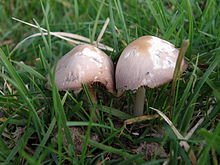- Coprophilous fungi
-
Conocybe rickenii growing from animal dung

Coprophilous fungi (literally dung-loving fungi[1]) are a type of saprobic fungi that grow on animal dung. The hardy spores of coprophilous species are unwittingly consumed by herbivores from vegetation, and are excreted along with the plant matter. The fungi then flourish in the feces, before releasing their spores to the surrounding area.
Contents
Life cycle
Coprophilous fungi release their spores to the surrounding vegetation, which is then eaten by herbivores. The spores then remain in the animal as the plants are digested, pass through the animal's intestines and are finally defecated. The fruiting bodies of the fungi then grow from the animal feces.[2] It is essential that the spores of the species then reach new plant material; spores remaining in the feces will produce nothing. As such, some species have developed means of discharging spores a large distance.[3] An example of this is the genus Pilobolus. Fruiting bodies of Pilobolus will suddenly rupture, sending the contents over 2 metres away.[4]
The animal feces provides an environment rich in nitrogenous material, which has been largely sterilised by the high temperature, as well as the enzymes in the animal's digestive system. The spores themselves survive digestion by being particularly thick-walled, allowing them to germinate in the dung with minimum competition from other organisms.[2] This thick wall is often broken down during digestion, readying the spore for germination.[1] The spores are so hardy that samples of dried dung can later be rehydrated, allowing the fungus to fruit weeks later.[5]
Distribution
The distribution of coprophilous fungi is closely linked to the distribution of the herbivores on which they rely, such as rabbits, deer, cattle, horses and sheep.[2] Some species rely on a specific species for dung; for instance, Coprinus radiatus and Panaeolus campanulatus grow almost exclusively on horse feces,[6] while others, such as Panaeolus sphinctrinus, can grow on any feces or even just particularly fertile soil.[6] Further, some species (such as Conocybe rickenii) can be found in large numbers in areas where manure has been used as a soil fertilizer, such as in gardens.[7] Some coprophilous fungi are also known to grow from the dung of omnivores (such as Chaetomium globisporum from rat droppings) or even carnivores (such as Chaetomium rajasthanense, from tiger feces).[8]
Mushroom-producing species
Although not all coprophilous fungi produce mushrooms, there are many that do, particularly in the genera Coprinus, Panaeolus and Psilocybe.[1] Known species include:
- Bolbitius vitellinus[2]
- Deconica coprophila[9]
- Conocybe pubescens[2]
- Conocybe rickenii[7]
- Coprinus niveus[7]
- Coprinus narcoticus[7]
- Coprinus patouillardii[7]
- Coprinus radiatus[6]
- Crucibulum laeve[10]
- Cyathus stercoreus[10]
- Panaeolus campanulatus[6]
- Panaeolus sphinctrinus[6]
- Panaeolus semiovatus[6]
- Psilocybe merdaria[9]
- Stropharia semiglobata[9]
References
- ^ a b c Lepp, Heino; Fagg, Murray. "Dung fungi". Australian National Botanic Gardens. http://www.anbg.gov.au/fungi/ecology-dung.html. Retrieved 2009-03-30.
- ^ a b c d e Pegler, p. 162
- ^ Wicklow, Donald T.; Carroll, George C. (1992). The Fungal community: its organization and role in the ecosystem. New York: M. Dekker. p. 715. ISBN 0-8247-8605-X. http://books.google.com/?id=ikJfKaz0lEEC&pg=PA715&dq=coprophilous+fungi. Retrieved 30 March 2009.
- ^ Deacon, J. W. (1997). Modern mycology. Oxford: Blackwell Science. p. 166. ISBN 0-632-03077-1. http://books.google.com/?id=WQldeYhfy-EC&pg=PA166&dq=coprophilous+fungi. Retrieved 30 March 2009.
- ^ Richardson, Michael J. (2001). "Coprophilous fungi from Brazil". Brazilian Archives of Biology and Technology (Brazilian Archives of Biology and Technology) 44 (3): 283–289. doi:10.1590/S1516-89132001000300010. ISSN 1516-8913. http://www.scielo.br/scielo.php?script=sci_arttext&pid=S1516-89132001000300010&lng=en&nrm=iso. Retrieved 30 March 2009.
- ^ a b c d e f Pegler, p. 164
- ^ a b c d e Pegler, p. 163
- ^ Lodha, B. C. (December 1964). "Studies on coprophilous fungi. II; Chaetomium". Antonie van Leeuwenhoek 30 (1): 163–167. doi:10.1007/BF02046722. PMID 14195246.
- ^ a b c Pegler, p. 165
- ^ a b Brodie, Harold J. (1975). The Bird's Nest Fungi. Toronto: University of Toronto Press. pp. 101–102. ISBN 0-8020-5307-6.
Further reading
- Pegler, David N. (1983). Mushrooms and Toadstools. London: Mitchell Beazley Publishing. pp. 162–165. ISBN 0855335009.
Categories:- Fungi
- Feces
- Detritivores
Wikimedia Foundation. 2010.

